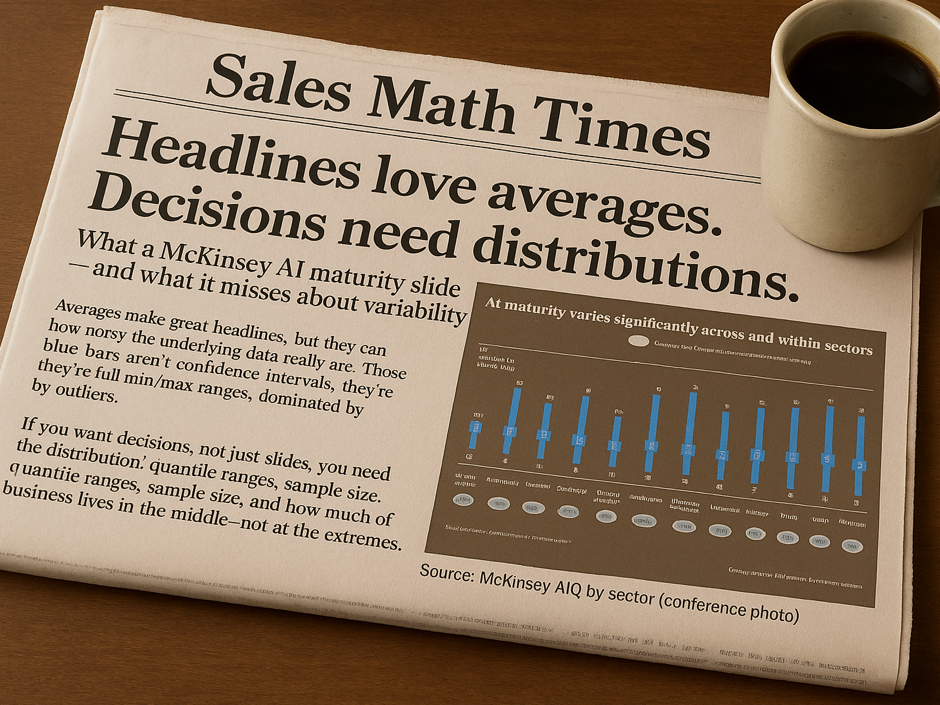All forecasts are wrong. Some are useful.
- Bill Kantor

- Oct 9, 2023
- 4 min read
Updated: Sep 19
“How accurate are your forecasts?” Almost everyone goes there when evaluating sales forecasting applications. And it makes sense. Who wants inaccurate forecasts?
But your forecasts will be wrong. Focusing on accuracy is a distraction. It is perhaps the least important thing you should get from a forecast. A forecast should help you sell more—by focusing your attention on things you control and that directly affect your success.
Let's put that distraction in context. Before you close a deal, you have to advance it to a better sales stage. Our empirical evidence shows that advancing your most impactful deals—typically ~5% – 10% of your open funnel—will have a comparable effect to advancing all the others. And, if you advance those most impactful deals, they can increase your sales by 20% – 50% in the quarter. Would you rather focus on forecast accuracy, or identifying the deals that get you 20% – 50% more sales?
Accuracy is important of course. But there are limitations that make pursuit of accuracy silly. And because of these limitations, I’ve come to realize that “how accurate” is not the right question—especially when dealing with new or expansion business, which is what we are focusing on here, and what most sales leaders are focused on.

I am not making excuses. Our forecasts are excellent. In head-to-head comparisons, we’ve consistently beat others. But forecast accuracy is limited by reality. Obsessing over it will lead to frustration.
More important, the quest for hyper-accurate forecasts misses the point. The goal is to maximize sales, not to maximize forecast accuracy. And unlike the weather, you can control your sales. A forecast that it always right is, by definition, not helping you sell more. The point of a model is to inform how to change things. It's not about the accuracy, it's about the insights that help you change the outcome.
What else you should get from a forecast
Which opportunities most improve your chances of meeting a goal
When to focus on them
Which opportunities are at risk
Which business segments are most productive
How much lead generation you need to meet your plan
What are the odds of exceeding a goal
How do those odds change based on factors you control
Unrealistic claims
A misguided focus on accuracy has led many analytics vendors to make outrageous and unsupportable claims. Here are a few:
"Consistently deliver quarterly revenue predictions with 98% accuracy as early as week 1 in the quarter"
"Unlock the Secrets to 95% Accuracy"
"How to Forecast With 95% Accuracy"
"Get 98%+ Sales Forecasting Accuracy. This quarter, and the next. And the next."
Impressive. But it’s a pile of hooey.
Here is an example of why this is impossible. One of our customers recently had one deal triple in value on the day it closed. That deal was 17% of their business that quarter, making a forecasting error of greater than 10%. Events like this—and even more severe swings—happen. They make it very hard to get early, accurate, and uniform (consistent over time) predictions.
What is realistic?
Imagine an idealized modeling scenario where you have:
A lot of deals
Of the same size
With equal and high probability of closing
A forecasting model that exactly knows each deal’s probability of closing
No new deals enter the sales funnel after the forecast is made
The future is like the past
Under these unrealistically rosy assumptions, if you have 500 deals in your quarter, each with a 90% probability of closing, your forecasting model will only be within 2% accuracy about 80% of the time. (See our post on Accuracy and Repeatability for more on this benchmark.) Real-world scenarios are much worse.
It’s hard to find a realistic number of deals and probabilities where you can get ± 2% accuracy—even under the idealized conditions above. But no forecast model is perfect, you will have deals of widely varying probabilities and sizes, or that change in size—sometimes dramatically—as the deal closes, and deals will enter your funnel after the forecast. The future may not be like the past. Each of these conditions further erodes forecast accuracy.
Bottom line. If a vendor claims to consistently deliver better than 15 – 20% forecast accuracy more than 80% of the time, they are lying or have very unrealistic assumptions about your business.
See how to sell more. Try Funnelcast. |
All forecasts are wrong, here is how they can be useful
Statistician George Box famously quipped: “All models are wrong, some are useful.” His point was that you should focus on how a predictive model can be useful rather than if the prediction is always correct.
What makes forecasts useful is understanding which factors have the most impact on what you will sell. And how changing them affects the odds of exceeding your goal.
Advice like "if you can advance these 10 deals you will add 20% to your expected outcome this quarter" is very useful. Contrast that with "Here a forecast that we claim to be 98% accurate," "here's how many emails you sent/received," or "your coverage ratio is 3.2x." What do you do with those statements?
Don't chase unattainable accuracy goals promoted by many CRM analytics vendors. Focus on factors you control. Understand their impact on sales. Unfortunately, most CRM analytics vendors lead you astray with wild accuracy claims. They also tout metrics that are uncorrelated to sales, presented without context, or even computed incorrectly.
Look at that list of things you should get from a forecast above. If your forecasts are not giving you those insights, if they are not telling you which deals and factors to work on at the right time, perhaps you need another forecasting application.




Comments